|
We stopped for morning tea under some trees. Gee pulled out
the supplies, and we had our choice of tea, coffee or hot
chocolate, along with rusks and cookies. Paula recognized the
spot; it was where we had once watched a jackal steal some tasty
morsels from a lionís kill. A beautiful Burchell's Starling
serenaded us from his perch on a bush, his feathers a brilliant
blue in the sunlight. I found a thick course hair on the ground
that I was sure must be from the tail of an elephant.
From our tea spot we could see a
herd of wildebeest with several smallish babies. The calves are a
light golden-chestnut color, and are much prettier than the
adults. As they grazed several of the babies got down on their
knees to better reach the grass with their short necks.
|
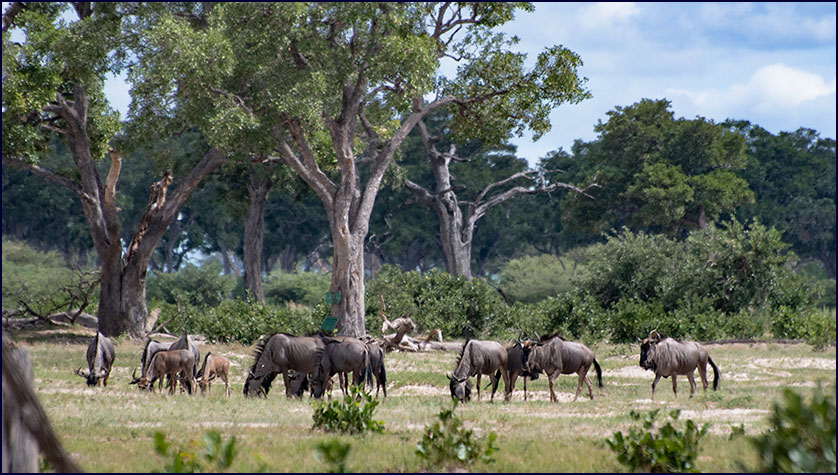
Tea break with the wildebeests
|
A Kori Bustard made his way through the grass. These
attractive turkey-sized birds are said to be the heaviest flying
bird in Africa Ė but usually we saw them walking, not flying.
They are the national bird of Botswana.
Another large elephant walked
silently by and then disappeared into the bushes. It never ceases
to amaze me how quiet these huge creatures can be, and how quickly
they can vanish into the underbrush. Now you see him, now you
donít.
Mid-morning we came to the edge of the Savuti Marsh and
looked out over this flat dry plain of open grassland. It seems
incongruous to call it a marsh, but when the erratic Savuti
Channel flows it brings water to this area and it becomes a marsh
again. The flat expanse is punctuated with the skeletons of dead
camelthorn trees which grew when the marsh was dry, and then were
drowned the last time the waters returned.
As
we skirted the Marsh we kept an eye out for cheetahs. They depend
on sight and speed to hunt so they like the wide open plains. Gee
said that cheetahs and lions like to lie in the shade of the
scrubby trees, so we scanned the shadows intently looking for
large cats.
Suddenly I saw the
elegant outline of a feline head. Lions! Five of them! There were
three adults and two youngsters, all of them females, lounging
under some scrubby trees.
|
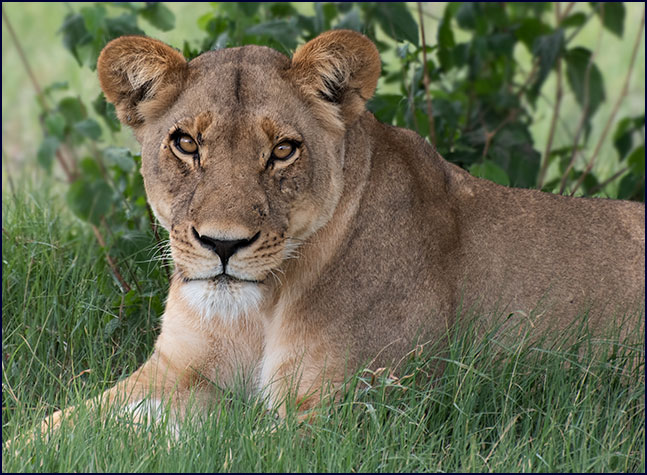
Motsumi
|
Gee said this was the Marsh Pride, which have been filmed a
lot and are famous. One of the lionesses was an older female with
scars on her face; she seemed wise and serene. Gee told us she was
named Motsumi; I had read about her in the Joubertsí book The
African Diaries.
The lionesses seemed content to
sleep in the shade. We relished the opportunity to watch them at
such close quarters. Gee told us that the black and white markings
on the backs of their ears help them see each other when hunting
in the night. Researchers identify individual lions by counting
their whisker spots.
Now and then one of them would get
up and move as the shade shifted. The youngsters were flat out,
while the mature lionesses dozed in a sitting-up position. Every
so often one would gaze around intently, checking to see if
something tasty had wandered near. There were zebras in the
distance, shimmering in the mirages of heat waves; the lions kept
an eye on them.
Motsumi opened her mouth in a wide yawn, stretching
luxuriously before ending the yawn with her lips drawn back in
what looked like a vicious snarl but wasnít. Two of the
lionesses rubbed heads together and licked each otherís faces
lazily, one hugging the otherís head in a loose embrace. It was
very tender. We were pretty happy to have found lions on our first
day.
Leaving the lions to their afternoon siesta, we ventured
closer to the shimmering zebras. Perhaps nervous because of the
proximity of lions, they were shy and did not let us get too
close. Mirages across the plain made it look like Leopard Rock was
floating on water. Fluffy white clouds crowded the sky.
We came upon three Southern Ground Hornbills. These huge
black birds with red faces are kind of ugly, but in a cool way.
One of them was up in a tree; used to seeing them on the ground
walking, I had not realized they could fly. A family of Warthogs
grazed near the track, several babies with their mother. When we
got close they ran away from us with their tails held straight up
in the air over their backs.
|
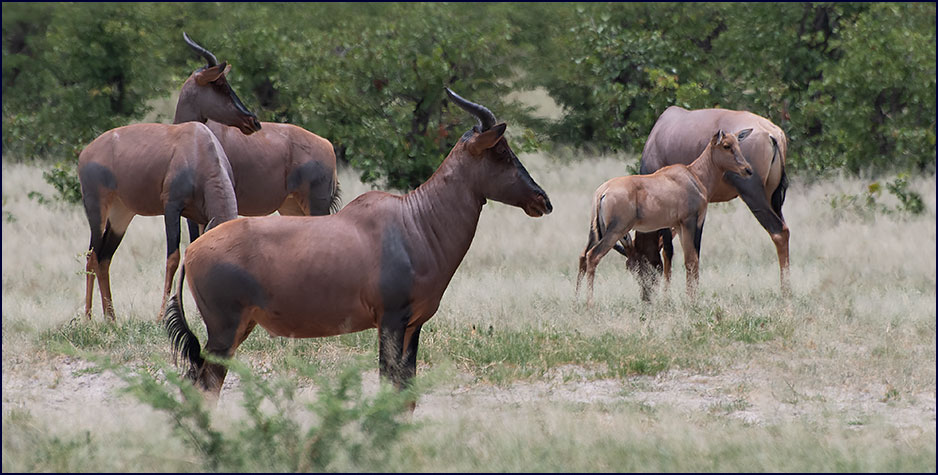
Tsessebes
|
A small group of tsessebes hung out with a lone wildebeest.
There were several tsessebe calves with the group; they were a
pale blondish-brown, a much different color from the adults Ė
and they were much cleaner! The calves looked like they were a
different species than their mothers - maybe they were adopted.
Again we were struck by how many more birds there were in
summer, with many that were different from when we came in winter.
Among others we identified the Southern White-crowned Shrike, a
Montegu's Harrier, and a pair of Wattled Starlings. A Red-backed
Shrike perched on a tree stump and posed for a picture, and an
African Harrier Hawk viewed us from a lofty perch in a tree.
Four bull elephants stood near the road as we headed back
to camp, and two of them were especially enormous. They were well
covered in wet mud; apparently they had just partaken of a mud
bath.
When we
returned to camp and climbed out of the land cruiser BD was
holding a tray with goblets of fruity tea for us, and KK was
waiting with moist towels to wipe off the road dust from our face
and hands. (They greeted us thus at the end of every game drive
for the trip.)
Before leaving home I had noticed a rubber snake on
Amazon.com, and decided that it would be a good thing to bring
along on safari. It was about four feet long and quite realistic
looking, and was identified as a black mamba, a deadly venomous
African snake. I named him Samba the Mamba and packed him secretly
in my suitcase. Perhaps I would play a little joke on Jineen.
Our tent was just big enough
for two camp beds with tiny bedside folding tables. There was a
little overhang on the front we called the verandah with a canvas
folding washbasin. At the back of the tent a zippered door opened
into a canvas-sided bathroom stall, open above, that contained a
bucket shower and a wooden toilet set over a deep hole dug in the
ground.
Before we went to lunch Jineen
remarked on the fact that there was a gap in the canvas at ground
level in the back of our shower stall, large enough that something
could come in through it. This seemed like a good time to bring
out Samba the Mamba, so I secretly coiled the rubber snake up just
inside the gap in the wall.
|
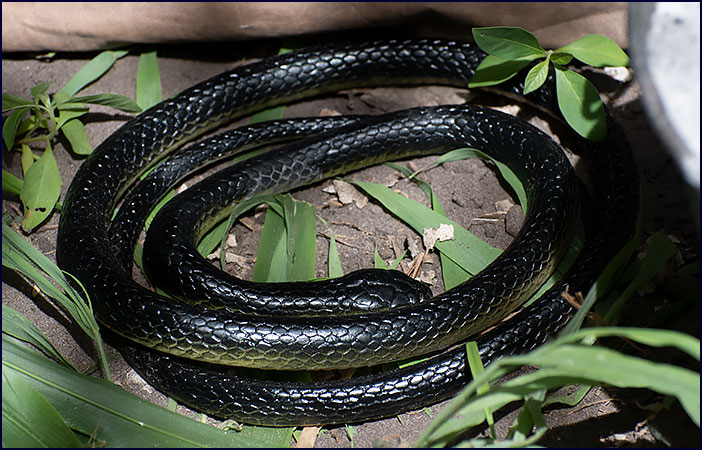
Samba the Mamba,
|
Lunch was ready for us; a delicious meal of homemade pizza,
cauliflower salad and fresh baked bread. Life, the cook, had
outdone himself. After the meal we had a little time to relax at
our tents and shower.
Walking back from lunch, Jineen
looked around the campsite and down into the riverbed and mused,
ďI wonder if there are snakes here?Ē It was all I could do to
keep from bursting with laughter. I told Jineen she could have
first turn in the shower. I waited in the tent while she went into
the canvas-sided stall.
I heard a surprised gasp, and
Jineen called out ďThereís a snake in our shower!Ē Before I
could react she hurried out and called to our guide, telling him
about the snake. Immediately Gee came to check it out, along with
BD and KK. Now all three of the men were either in our tent or
peering over the shower wall from outside, talking urgently to
each other in Setswana. There was a definite sense of alarm.
Meanwhile, I was torn between
laughing hysterically, or thinking Oh
crap, what have I done? Iím not really sure what I expected
to happen, but not this. There was some mention of getting the
book to identify the species, and Gee cautioned us to stay back. I
got the definite impression they were trying to avoid scaring the
guests (us) by revealing that this was a dangerous viper, while
making sure we did not get close enough to get bitten. Gee poked
the snake with a long stick but it did not move. ďThis snake is
dead!Ē he exclaimed.
At that moment both Gee and Jineen
realized that the snake was rubber, and we all about collapsed
from laughter. Everyone thought it was a great joke (fortunately),
and Samba the Mamba became a camp mascot and went on all of the
game drives from then on.
We headed back out on safari just after three. We started
out with birds again - birds of prey this time. A Steppe Buzzard
flew off from his perch in a tree. We watched a Bateleur in
flight, the feathers at the tips of his wings outspread like the
hands of the French tightrope-walkers he is named for. A beautiful
golden-brown Tawny Eagle stood regally in a treetop, gazing out
over the plain.
|
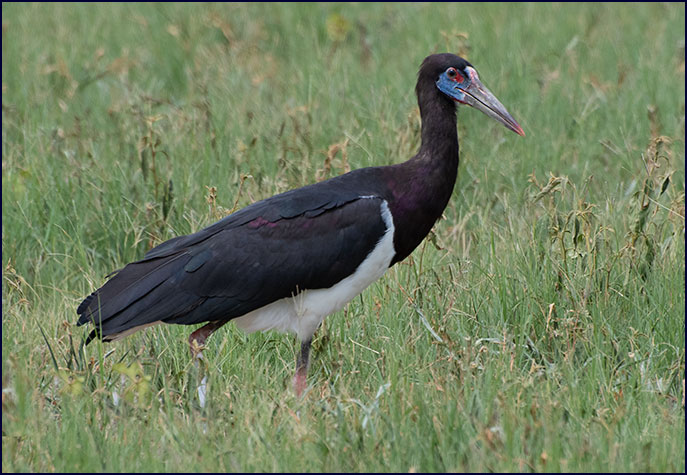
Abdimís Stork |
About two dozen Abdimís Storks gathered at a pan
(waterhole); these large birds are mainly black, with white
undersides and sky blue featherless skin around their faces.
Nearby a lone wildebeest bull stood with a herd of impala; he was
guarding his territory while his females lived together somewhere
else, and hanging out with the impala for help spotting predators.
A bull elephant came striding past
the waterhole, scattering impala and waterfowl in his path; Gee
said he was in musth (a
state of sexual readiness accompanied by high testosterone levels
and aggressive behavior) and looking for a mate.
|
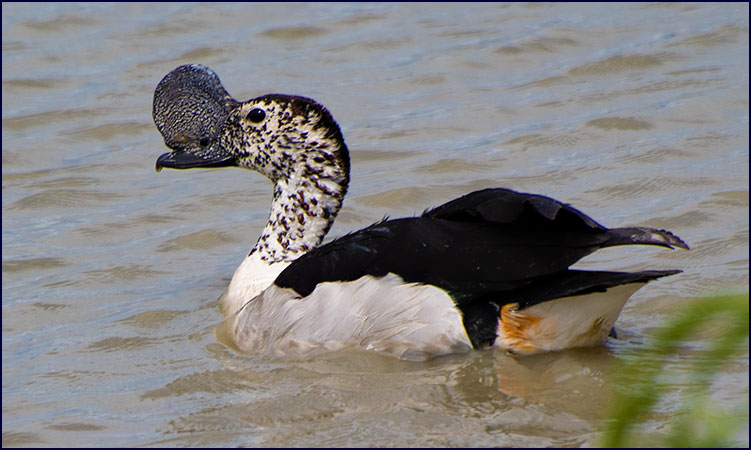
Comb Duck
|
At the next pan we got a good
close look at a pair of Comb Ducks. These large black, grey and
white ducks have speckled heads and the males have a big round
disc attached to the top of their beak on the front of their
faces. I thought it looked ridiculous, but apparently the female
comb ducks find it irresistible.
A beautiful little Wood Sandpiper was wading in the edge of
the waterhole, dabbling in the mud. A Blacksmith Lapwing stood by
the water; we saw these striking black, white and grey birds
often. A small attractive Three-banded Plover put in an
appearance. A Lilac-breasted Roller flew low over the grass
hunting for insects, his brilliant colors vivid in the sunlight.
|
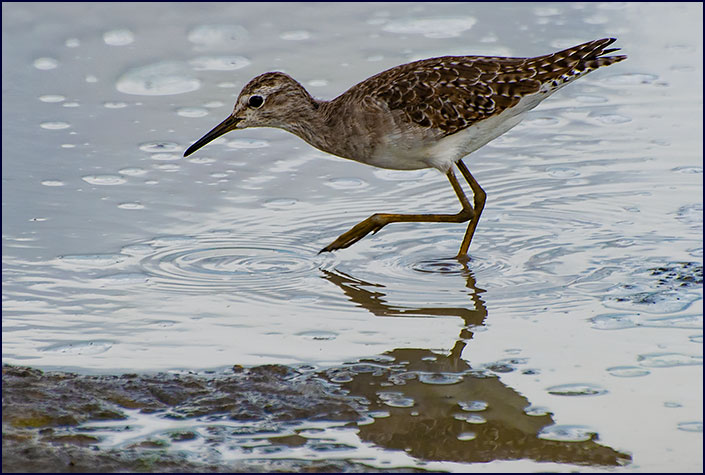
Wood Sandpiper
|
There was a good assortment
of Hornbills. As usual the Red-billed Hornbills were everywhere. A
Grey Hornbill perched on top of a stunted Mopane tree, and we
passed several of the attractive Bradfield's Hornbills. My
favorites, the Yellow-billed Hornbills, are very precocious. They
are always the first ones begging for food at the tea breaks, and
they are very photogenic.
As we went on we saw more and more birds and it was a fun
challenge to identify them. Gee knows his birds, and Sally is an
expert at identifying them as well, consulting the African bird
book as needed. She said her goal was to see 200 different bird
species on this trip, and she kept an accurate list of each new
one we saw. I wonít try to mention every one of them here, but I
will include the list at the end of this journal.
We encountered another ostrich
family; this one had six babies, the smallest we had seen yet. The
baby ostriches are a mottled brown color with stripes on their
necks; they look like giant versions of baby quail.
As the afternoon got long the skies turned dramatic, with
fluffy white clouds giving way to dark ones, heralding rain in the
distance. It was quite different from the clear blue skies we were
used to on our winter visits. I thought back to my travel agent
talking of getting dramatic photos when the afternoon storms roll
in, like a male lion shaking the water off his mane after a rain.
I had a very vivid mental image of the photo I planned to take:
The magnificent King of the Beasts stands tall and proud,
side-lit by shafts of sunlight slanting down against the dark
stormy sky. As he shakes his head, water drops are glistening in
the sun as they fly off his luxurious mane. Godís rays reach
down from the heavens, illuminating the gleam in his eye, and a
double rainbow arcs across the sky above him. No doubt Angels
would be singing. I could hardly wait to find some lions.
A pair of giraffes walked across the plain in stately
elegance, a large male and a smaller female; they gazed at us as
they strolled by. They were absolutely beautiful. After a while
they were joined by two others, and they browsed in the trees a
while. Suddenly something spooked them, and all four took off,
their tails curled up over their backs. Giraffes run in a slow
motion cross-gallop that somehow manages to look elegant and
awkward at the same time.
A Long-tailed Paradise Whydah sat at the top of a dead
tree, tilting his head back and singing. He was one of the most
interesting, beautiful and unlikely-looking birds I have seen.
Mainly black, he had a red breast and white stomach. His tail was
four times the length of his body, and had a big feathered hump
near the base of it. He was amazing, and also slightly
ridiculous-looking.
We found the male lions! There were three of them sleeping
in the shade. Two were lying flat on their sides and the third one
lay on his back with his legs sprawled out in a most undignified
manner. Lions can look majestic when they want to, which isnít
all that often. There were no raindrops in their manes, nor
godís rays or rainbows.
Gee told us there had been five male
lions in the area, some from the Marsh Pride and some from the
Northern Pride, and they had formed a coalition to guard the
territory together. But then one was killed by a cobra and one was
trampled by an elephant, so now there were only these three left.
Another lion had come into the area from elsewhere, and he had
been very aggressive, fighting and chasing vehicles. These three,
protecting their territory, had driven him away.
We watched the lions as they dozed. From time to time one
would get up and look around, scouting for possible danger or
prey, and then move to a new patch of shade and flop back down
again. Then another would sit up, gaze at us attentively, then
yawn and go back to sleep.
One of the lions in particular was
very large. His abundant mane was caramel colored around his face
but black near his chest and shoulders. Presently he got to his
feet and stretched, standing tall and looking for all the world
like the King of the Beasts. For a moment he stared intently at
us, showing no fear. The sheer power he displayed made a shiver
run up my spine.
By now we were well-used to the fact that most of the
animals paid us little attention as long as we remain in the
vehicle and stay quiet. They donít see us humans, but as part of
the big strange land cruiser animal; they take no more notice than
they would of a giraffe or an elephant grazing nearby. And in a
park where they have not been hunted by man, the lions have little
to fear Ė they are at the top of the food chain.
At lunch Gee had told us about how
lions sometimes interact with humans. They do not usually stalk or
hunt people for food, though they would attack if one got too near
them to protect their territory. However, once a lion kills a
person and eats it, even if somewhat accidentally, the lion will
then kill again and again, and the whole pride has to be
destroyed.
We left the lions in peace and spent the evening with
elephants. Four big bulls were feeding on the mopane trees, and
they did not seem to mind when we parked close by and watched them
for a while. Then we went on to the series of pans we had formerly
dubbed the Elephant Spa and watched as the herd came down to drink
and bathe. It was a bachelor herd, all males. They pawed and
splashed in the pan, sucking up great trunk-fulls of water and
spraying themselves. One of them lay down and groveled in the
muddy water. From time to time one of them would lift a foot and
sway back and forth, rubbing one leg against another in what
looked like a dance, but he may have been just scratching an itch.
Several young adult bulls began tussling head to head,
intertwining their trunks and shoving, pushing each other
backwards like a reverse tug-of-war.
Finally the elephants all turned and filed away, leaving us
to watch two impala bucks sparring beside the waterhole. There
were half a dozen Spurwing Geese by the water, and an Egyptian
goose with seven small babies.
It
was getting late as we left the Spa and the light was starting to
fade. A pair of tawny eagles perched in a dead tree silhouetted
against the evening sky Ė one of them took off and flew across
the dusky sky. A breeding herd of elephants, mothers with babies,
filed across in front of Leopard Rock.
It was near dark when we went back to check on the lions. One of them had moved
off a ways but the other two were sitting up and looking around.
We could see the battle scars on the big oneís face; the other
one had a blonder mane and looked younger. The older lion tilted
his head back and opened his mouth in a mighty yawn. He tipped his
head further and further back as he continued to yawn expansively,
until he finally just flopped over backwards onto the ground for
another impromptu nap.
Gee said the lions were getting restless and might get up
to go hunting soon - but unfortunately we could not stay and watch
them as park rules said we must be in camp by 7:00 pm.
Gee drove fast as we watched the last of a vivid sunset,
with dead trees standing starkly against the glowing clouds. We
arrived in camp as the last light faded from the sky.
Our chairs were waiting for us in
a semicircle around the campfire. We sat by the fire and
contentedly recounted the highlights of the day. Life came out to
our circle and announced dinner, and BD called us to table with a whistle
like a pearl-spotted owl.
|